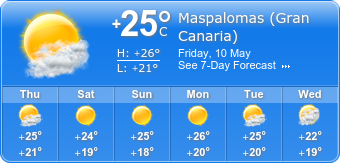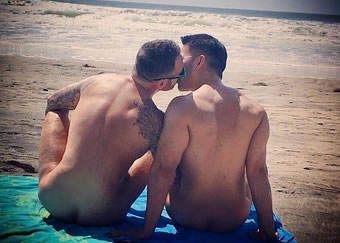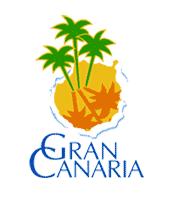|
| Weather in Gran Canaria | |||||||||||||||||||||||||||||||||||||||||||||||||||||||||||||||||||||||||||||||||||||||||||||||||||||||||||||||||||||||||||||||||||||||||||||||||||||||||||

.jpg)




|

The prevailing north-easterly Trade Winds deposit their rain on the northerly slopes of the Island, leaving the south-west in a rain shadow. The contrast caused by this difference in rainfall can easily be seen when driving around the Island - The south-west coast being semi-desert, while the northern mountains are lush with greenery. Summers are generally dry everywhere on the Island, although the northern half tends to have more cloud cover. In Winter, the difference between the north and south is even more pronounced, with the southern resorts often a few degrees warmer than Las Palmas. Altitude is the other major factor and it is not unknown for Puerto Rico to be basking in the mid-twenties, while there is snow on the peaks just a few kilometres away.

Calima Calima is the local name for the (sometimes thick) haze experienced in the Canary Islands when dust is blown across from the Sahara Desert (just 220km away). When this occurs, everything becomes covered in a fine red dust and the temperatures rise. While not life-threatening (it is not the same as a desert sand storm), many people complain of hay fever-like symptoms during a thick Calima. Storms Big Storms are extremely rare in the Canary Islands, though a Tropical Storm (Delta) did sweep through the Canaries in November 2005. This was the first time that a Tropical Storm had been recorded in the islands and it caused a great deal of damage, including the destruction of the famous Dedo de Dios (God's finger) natural rock structure that had stood for thousands of years.

Okay, but what will the weather be like during my Holiday? If you go during the summer (mid-April to mid-October), you are pretty much guaranteed sunshine and hot weather in the south. During the Winter (if you can call it that), Gran Canaria does receive some rain, so there is always a chance of that, though temperatures will most likely rise to the low to mid twenties even in January. It can become chilly in the evening though, so it's a good idea to bring a jacket or cardigan. January & February temperatures average nearer 25°C / 77°F with high humidity, often windy and this is when it's most likely to rain here in the south. Parts of the island (usually the north or central areas) flood & dry beds become rivers as reservoirs overflow. Fortunately, a rainy spell rarely lasts more than a day and is usually followed perfect, holiday weather the day after! As well as the rain we have the occasional sandstorm caused by the "calima" - a cloud of sand blown in from the Sahara. They're not as bad as they sound. It's something to be seen rather than avoid and there's no problem spending the day on the beach enjoying the sun that shines through them. Imagine them as kind of a fog that doesn't spoil your sunbathing. The hot wind that blows from the Sahara is known as the "siroco" and also arrives this time of year.

Thanks to the rains around January, the island becomes very fertile and green for the early part of the year. The north of the island has a different climate, so if you're getting weather information relating to the capital, Las Palmas, you'll find it's always 5°C or 10°C (approximately) cooler up there. It also receives more rain and clouds than the south, as do the rest of the Canary Islands. Puerto Rico and the immediate area on the south west of Gran Canaria gets the sunniest and hottest weather throughout the Canaries. The mountains in the centre of the island have a different climate altogether. Often it's quite cool with fresh winds, most of the island's rain falls here and during winter it's not that unusual to find snow whilst the south of the island still has hot, sunny weather. By night the temperature stays around 15°C / 59°F or a little more all year round other than July and August where it can vary quite a bit from around 15°C / 59°F up to 25°C / 77°F some nights.

Average Temperatures
Average Rainfall

Average Sea Temperature & Sunshine Hours

 |
|
|||||||||||||||||||||||||||||||||||||||||||||||||||||||||||||||||||||||||||||||||||||||||||||||||||||||||||||||||||||||||||||||||||||||||||||||||||||||||

|
HOME | CRUISES CALENDAR | GAY GROUP CRUISES | RESORTS CALENDAR | TOURS CALENDAR | GAY DESTINATIONS | SITE MAP | LINKS
|
|

 Gran Canaria enjoys a sub-tropical Climate with mainly spring-like temperatures throughout the year, sun beating down for about 50 weeks of the year. That said, this 'Continent in Miniature' has several Microclimates, with some considerable differences in rainfall and temperature. March - June expect sunny weather with temperatures around 25-30° C/ 77-86° F, the hotter days around 35°C / 95°F. July & August is the hottest time of the year averaging 35°C / 95°F by day, occasionally peaking nearer 40°C / 104°F on some days.
Gran Canaria enjoys a sub-tropical Climate with mainly spring-like temperatures throughout the year, sun beating down for about 50 weeks of the year. That said, this 'Continent in Miniature' has several Microclimates, with some considerable differences in rainfall and temperature. March - June expect sunny weather with temperatures around 25-30° C/ 77-86° F, the hotter days around 35°C / 95°F. July & August is the hottest time of the year averaging 35°C / 95°F by day, occasionally peaking nearer 40°C / 104°F on some days.

